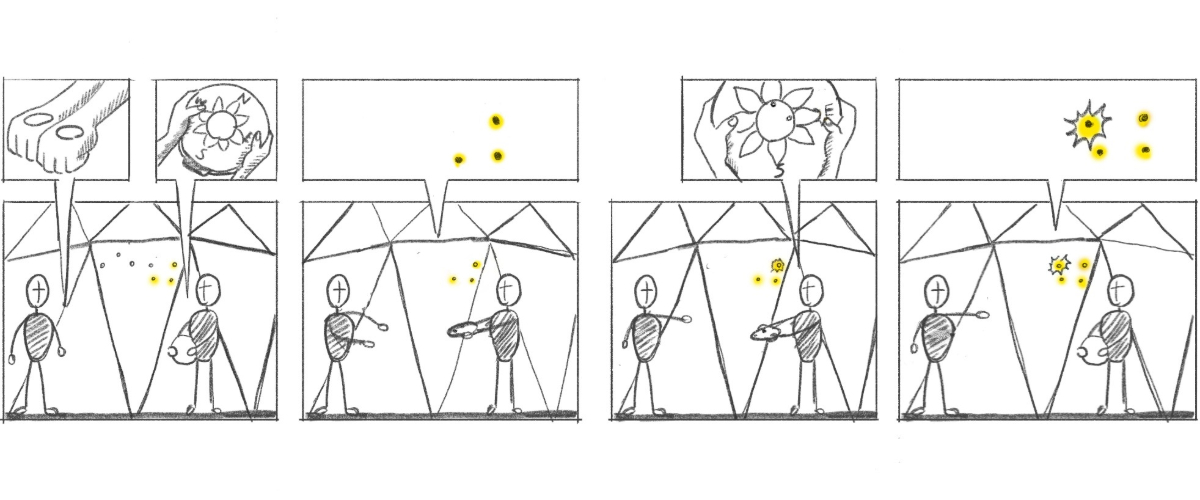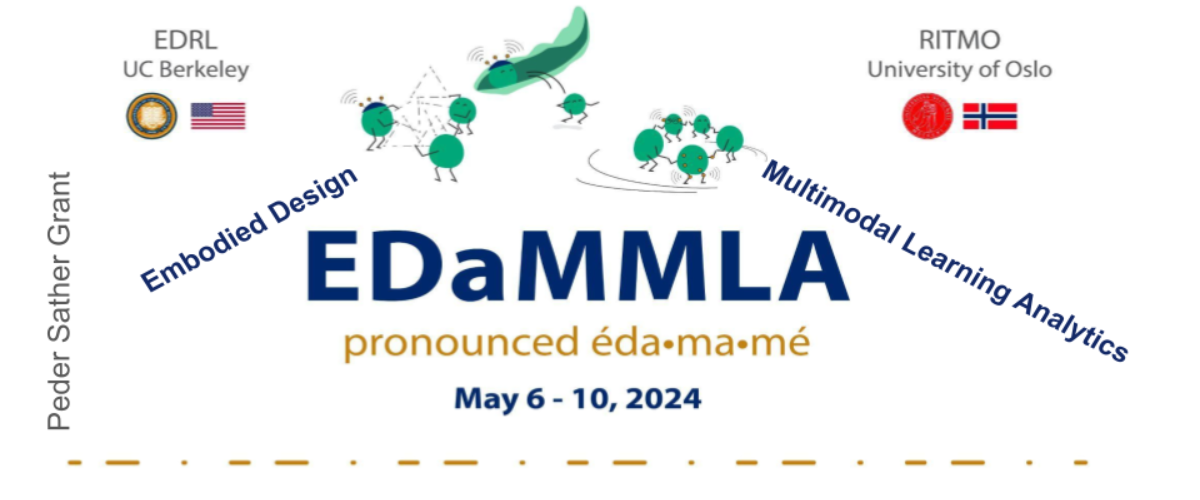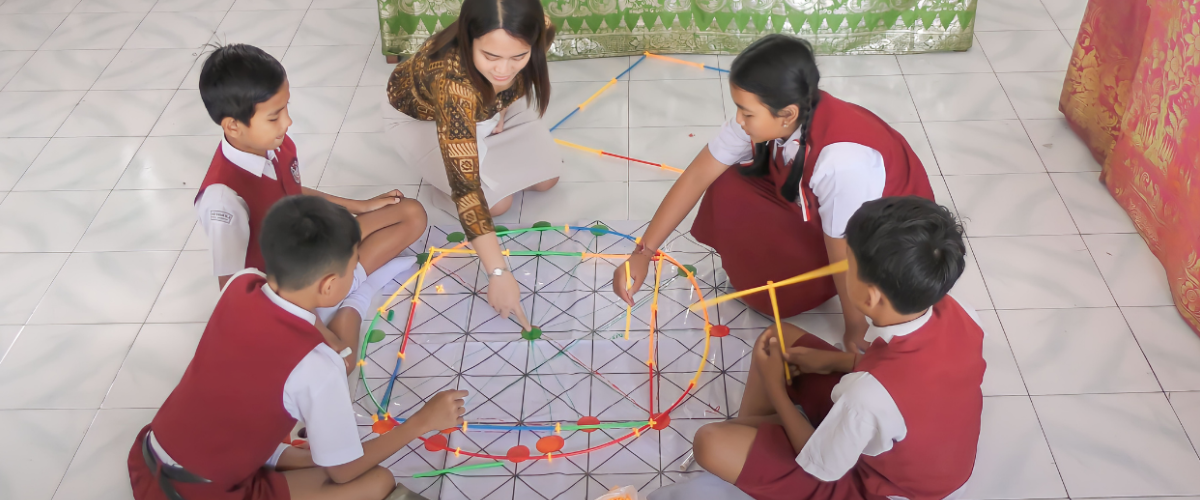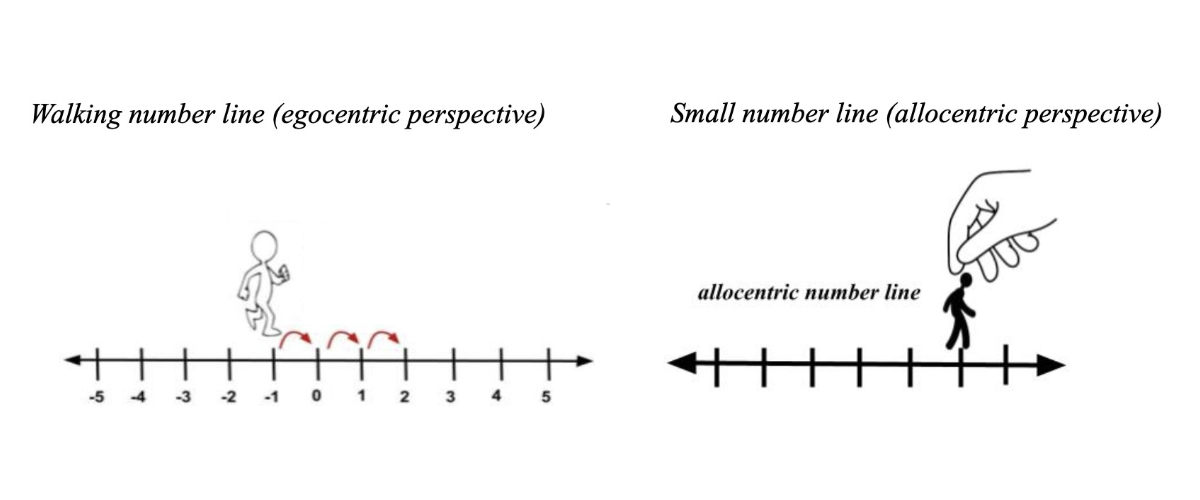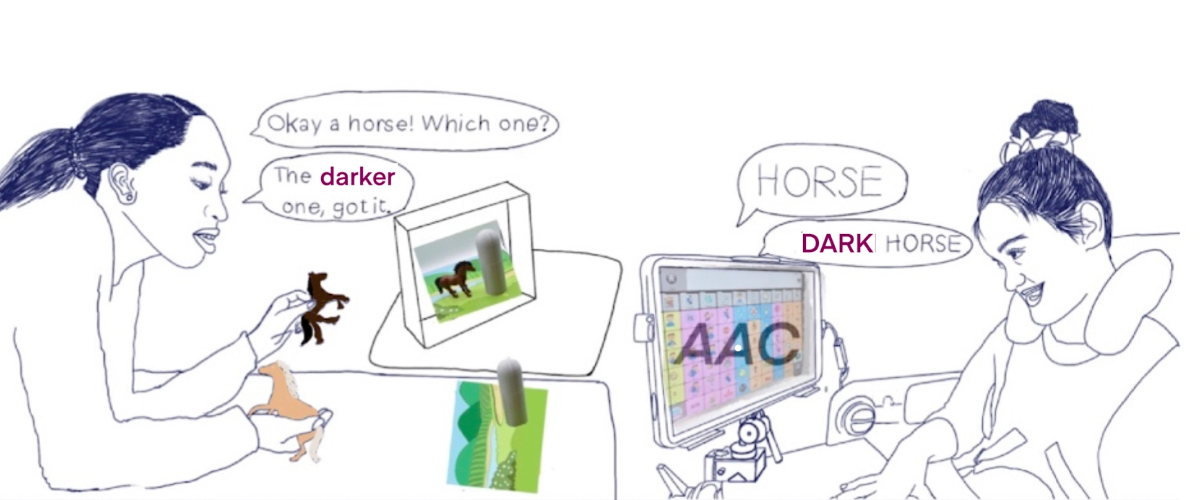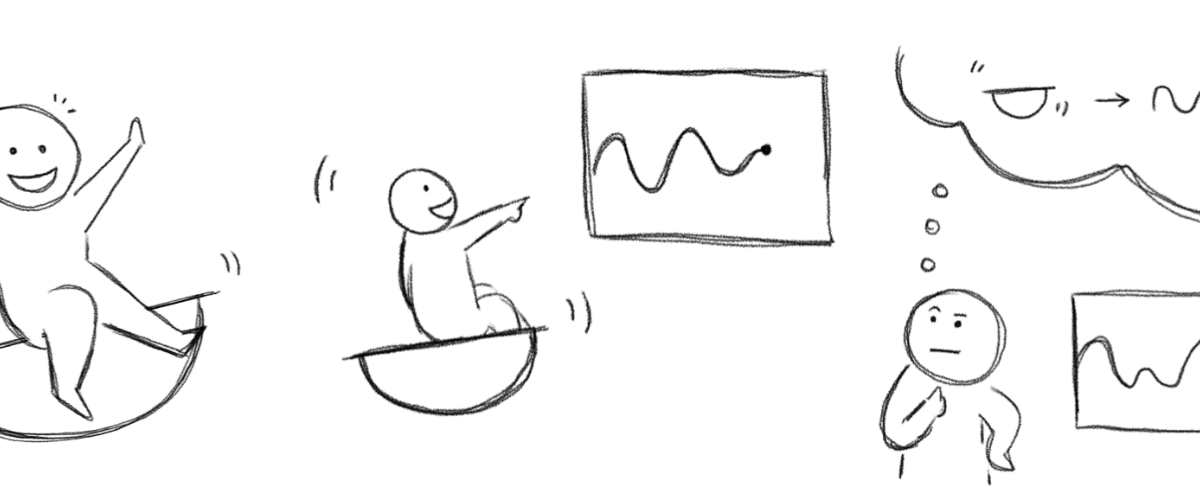- EDUC 203: Cultivating Cognitive Development: From Sensorimotor Intelligence to Embodied STEM Concepts (CCD)
- EDUC 222C: Design-Based Research Forum
- EDUC 290C: Cognitive Ergonomics in STEM Education Research: A Multi-Disciplinary Analysis of Objects to Think With
- EDUC 290C: Modeling-Based Methodology for Design, Learning, and Research
- EDUC 290C: Learning Chance: Computer-Supported Inquiry into Probability
- EDUC 290C: Principles for Embodied Design–Exploring Learning-Sciences Perspectives on a Body-Based Approach to the Design of Learning Environments
- EDUC 224B: Paradigmatic Didactical Mathematical Situations
- EDUC 130: Knowing and Learning in Mathematics and Science
EDUC 203: Cultivating Cognitive Development: From Sensorimotor Intelligence to Embodied STEM Concepts (CCD)
Course Description and Goals
Cultivating Cognitive Development (CCD) is designed to serve as a required course for Graduate School of Education students in the Learning Science & Human Development cluster of the graduate program. As such, it aims to introduce students to a body of literature representing one strand of LS/HD scholarship. In particular, this course offers graduate students a theoretical view on the development of Science, Technology, Engineering, and Mathematics (STEM) concepts, a view that promotes research attention to the apparent sensorimotor grounding of teaching and learning. In some sense, this course bridges the work of Piaget and Vygotsky. As such, a working hypothesis informing this line of research is that conceptual development is both enabled and constrained by perceptuomotor capacity (Piaget); at the same time, the social contexts, framings, and guidance of perceptuomotor entrainment are instrumental and constitutive of building these capacities and, therefore, of learning STEM concepts (Vygotsky). The syllabus covers seminal work from cognitive developmental psychology as well as a variety of theories of human learning, both of movement and of STEM concepts, that ultimately inform the design of artifacts and activities for equitable STEM learning.
The notion that STEM concepts are grounded in perceptuomotor capacity is not new, and yet recently it has been recognized as championing, within education scholarship, key ideas from the embodiment approach to the philosophy of cognitive science. This approach is, in a sense, a return to—yet often a radicalization of—theories of learning put forth in the 20th century by developmental psychology luminaries, such as Dewey, Piaget, and Vygotsky, as well as phenomenological philosophers, such as Husserl and Merleau–Ponty, enactivist researchers, such as Maturana and Varela, and cognitive linguists, such as Lakoff. As we will discuss, the definitions and intellectual boundaries of embodiment philosophy and theories are still evolving. However, what is shared across the board is that, in contrast to traditional Cartesian epistemological stance that delineates the brain from the body, we are looking to rethink the mind as expanding beyond the brain organ; we characterize cognition, even when you’re thinking with your eyes closed, as necessarily embodied and dynamical enactment that is extended through the body to be embedded in the environment as mediated by tangible and intangible cultural forms. Thinking is constituted in, and endures as your perceptuomotor equipped capacity to engage the environment. Thinking with your eyes closed is cultural activity.
For educational researchers, highlighting the sensorimotor quality of cognitive activity poses questions with respect to “taming the naive mind”—a sophisticated mind, for sure, yet one that was evolutionarily selected for adaptively coping with rudimentary biological demands, such as fight-or-flight, and has not yet caught up with historically recent changes in cultural ecologies, such as tax forms, polling machines, or parallel parking, which permeate urban civilization. As such, how do we learn all this stuff that we will need to do as adults? How, for example, might finger-counting relate to using electronic devices to perform arithmetic operations on symbolic notations? What goes on when we read an algebraic word problem? How are we able to debate with our colleagues mathematical objects that do not exist as material entities and, in fact, have never been presented in any palpable or other concrete form for sensory inspection? Are mathematical notions abstract or concrete? What might all this mean for the design of STEM learning environments? For example, if learning is moving in new ways, then how should students move so as to learn some target concept, how do we get them to move that way, and how will they make mathematical sense of these movements? The field has not yet answered these questions adequately, but there’s some useful work out there, and the course hopes, at the very least, to make the questions somewhat approachable.
The course will mostly follow a historical survey of research literature relevant to CCD, as outlined above. We will read from cognitive-developmental psychologist Jean Piaget, then turn to overviews of the embodiment turn in the cognitive sciences, reading from Varela (enactivism), Gibson (ecological psychology), Mike Turvey (ecological perception), Noë (perception as action), Clark and Chalmers (the extended mind), Hutto and Myin (radical enactivist cognition), Thelen and Smith (dynamic systems theory of motor development), and Scott Kelso (coordination dynamics), as well as selected readings on motor development, such as Bernstein and Adolf. Our focus will then turn to discussing implications of this body of literature for STEM education, a conversation that will be grounded in some of the design-based research conducted by members and collaborators of the Embodied Design Research Laboratory at UC Berkeley’s Graduate School of Education (Abrahamson, Director).
Woven into these reading and discussions are several landmark assignments, including analysis of videotaped Piagetian clinical interviews about conversation of volume; a free-play observation task; and video-taping and analyzing the process of someone learning to perform some physical task (like tying shoes or flipping pancakes). These assignments are designed both to contextualize and ground the readings as well as to introduce course participants to common methodologies in educational research, and in particular the forms of qualitative analyses we engage in prior to, optionally, conducting quantitative analyses. The course will be hosting a line-up of guest lecturers (albeit, unfortunately, Jean Piaget has declined our invitation). The course does not have an examination. Instead, course participants submit a final paper surveying the literature we have covered to outline a research proposal on a topic in STEM education, for example, composing an NSF-proposal for conducting a design-based research study on some aspect of some target population leaning some STEM concept.
Objectives
By the end of the course, participants will be able to:
- Articulate a critical perspective on the current body of philosophical, theoretical, and empirical literature relating sensorimotor development to STEM learning.
- Conduct qualitative analysis of multimodal data on movement and learning.
- Manage educational research studies: Build a research design, collect data, carry out qualitative analysis that applies appropriate theory and methods, interpret findings, and write a report.
- Develop a theoretically-grounded proposal for a research project in a STEM area of their choosing.
EDUC 222C: Design-Based Research Forum
Objective: Collaborative forum for advancing design-based research projects.
Course Description and Goals
DBR is a practicum course. It is forum for people interested in design to build something, try it out, and, along the way, learn a thing or two about learning. It begins with your own hunch about how to improve the teaching and learning of some concept or skill – you can choose any content, context, age group, and media. You will immediately begin acting on the hunch by building something, even a mock-up. This will help you think about the hunch, but it will also help you explain the hunch to your cohort and instructor. While you build and operate the thing, you’ll probably notice stuff you hadn’t thought about before. To help you think about these new features, we’ll draw in some selected perspectives from the Learning Sciences that will be customized to your own project (so there’s no official course reader, but rather a couple of basic papers followed by “your” papers). So this is a different approach to learning about theory: theory in this course is not stuff you need to know as much as stuff you want to use. Theory is “on tap” rather than “on top” (I stole that from Papert) — theory is a tool for improving the design and making sense of how people use it.
This course usually attracts graduate as well as undergraduate students from throughout the GSE but also from other Cal departments and programs, such as BID, iSchools, Architecture, and so on, and other universities such as UCSF or Stanford. The objective is to “re-invent” design based research through collaboratively negotiating the discursive constraints of sharing and reviewing projects from across diverse disciplines. For example, in one semester I might have a surgeon inventing a new device, a philosopher studying an activity for learning prime numbers, and an engineer working with indigenous people on a sustainable-energy project… Quite often, students who take this course go on to develop their project into Position Papers, conference and journal submissions, and even dissertations. If you’d like to see what types of projects people do, you can check out a bunch of 1-page executive summaries.
EDUC 290C: Cognitive Ergonomics in STEM Education Research: A Multi-Disciplinary Analysis of Objects to Think With
Course Description and Goals
This is a course about stuff. More precisely, about things we live with, work with, think with, and — especially — learn with. Drawing on a variety of perspectives in the literature, we will examine human-made things. In particular, with an eye on educational design, we will focus on how (guided) interaction with these objects supports — or perhaps constitutes – learning. Ultimately, we will converge on what all this might mean for developing objects to think with, that is, how to conceptualize the design of learning tools in light of issues of content, pedagogy, and cognition.
Course participants will learn to bring to bear a range of analytic tools to make sense of artifacts, including objects, activities, and mediation practices. In one type of activity, we will deconstruct artifacts, such as an abacus, to reveal their text and subtext as well as how they might foster mathematical understanding and/or procedural fluency. In another type of activity, we will examine videotaped data from experimental implementations of innovative designs so as to address the theoretical and pedagogical challenges of leveraging an ‘artifacts perspective’ in educational practice and research. For a final project, students will analyze the process of learning something where an “educational” artifact is involved, including the detailed, literature-based, microgenetic interpretation of video footage of a person working with that artifact, whether or not the object is physically present and whether or not a facilitator is present.
Objects that might be of interest are, for example, a jigsaw puzzle, a computer interface, an algebraic equation, a map, a Rubiks cube, an abacus, a traffic light, an IKEA manual, or a toothbrush. But I will be open to considering any object. Participants are welcome to study objects that they are creating and/or investigating for their graduate requirements, e.g., aspects of a learning environment they are designing.
Participants will be encouraged to consider submitting a paper based on their term project to a conference (for example, ICLS deadline is Nov. 19 for the June 24-28 conference in the Netherlands); The GSE ‘Research Day’ would be another great opportunity to present your work.
Course Highlights
The course will include guest lectures from experts in diverse disciplines such as philosophy, semiotics, psychology, pedagogy, socio-cultural theory, graphical user interface (GUI), human-computer interaction (HUI), product design, bio-mechanics, equity, comparative literature, and aesthetics.
On how I intend for this course to meet the Individual and Social Cognition requirement.
I take the learning of STEM content to be an individual’s agentive and inventive gradual initiation into the complex manifold of activities inherent to socially constructed tecnho-scientific practice created and facilitated by fellow humans with taken-as-shared perceptual-cognitive faculties, pragmatics, argumentation norms, and epistemic dispositions. As a design-based researcher, I am particularly interested in examining the artifacts around which STEM practice and learning are organized. Only through understanding human (inter-) action with artifacts, I believe, can one begin to design artifacts that would be useful for learners of some targeted subject matter content.
Artifacts, in their broadest interpretation, are the fabric and conduits of everyday human being. Artifacts are squarely lodged at the intersections of personal/interpersonal distributed practice, perceptual judgment and conceptual understanding, history and future enterprise, and culture, society, and identity. Whereas the focus of this course is on tangible artifacts, the premise is that through instrumentalizing any cognitive artifact individuals broaden their epistemic horizons and participatory opportunities toward self-realizing participation in democratic society.
Unless one’s education research is carried out from a “purest” cognitive or socio-cultural perspective, social mediation is, at least implicitly, omnipresent in cognitive studies and, conversely, individual epistemology is the unsaid presupposition of all sociological studies. Naturally, then, for many contemporary scholars these perspectives are intrinsically complementary – learning is regarded as a complex phenomenon involving ongoing, dynamic reciprocal interactions among many agents; through acknowledging and harnessing this complexity we may develop richer understandings of the phenomenon of learning and, based on these, effective learning environments.
The majority of the course readings will be accordingly organized in two chapters that introduce rhetorical emphases on individual construction and social mediation, respectively. An ever-present thread through our discussions will be an investigation of relations among individual and social perspectives with an eye on integrating these perspectives into a more comprehensive model. (I think of this model as a circumspect ‘Phenomenology of Mathematical Artifacts’ that is central to an emerging ‘design theory’). A third chapter will investigate the roles of objects in collaborative work places. A fourth chapter will include a medley of writings that will round off our discussions by foregrounding other important aspects of learning objects.
Whereas I recognize the liability of a course on learning objects to appear too ambitious, the potential thinness of such divergence will be studiously counterbalanced by the intellectual drive to converge on a stable-enough model that regulates participants’ circumspection to both individual and social factors of learning. In a sense, it is precisely about building capacity to apply such structured circumspection that this course is about. That is, the course is not intended so much to lay out the gamut of essential readings for either a constructivist or socio-cultural perspective per se as much as to evoke a methodology – which I find useful – for examining the reciprocity of these perspectives, anchored in the case-study investigation of artifact-based pedagogical activity and its trajectories to professional practice. Design-based research on learning processes, I believe, can be effective only if both the individual and social aspects are considered. The availability of empirical cases as course resources will by necessity draw out the complementarity of individual and social factors underlying learning contexts, because these cases all portray (a collective of) individual students’ guided interaction with mathematical artifacts purported to foster deep conceptual understanding of some targeted content. Moreover, I wish to demonstrate the mutual constraints of cognition and acculturation as they play out dynamically in a teaching-learning situation (in what Solomon & Perkins, RRE 1998, call a reciprocal spiral relationship). That is, the very practice of designing for learning intrinsically conveys a notion of society seeking to foster individual knowledge. It is this intrinsic complementarity of the learning phenomenon that the course wishes to explore.
EDUC 290C: Modeling-Based Methodology for Design, Learning, and Research
Objective: Learning complexity-studies methodology for education by building agent-based models.
Course Description and Goals
The seminar focuses on technology-based modeling methods supporting a range of research practices within education and beyond. Specifically, we will explore: (a) design for student STEM content learning; (b) research on student STEM content learning; and (c) theory-of-learning research and development. Through these three research foci, a technology thread is agent-based modeling and simulation, a theoretical commitment is recognizing both individual and social aspects of cognitive development, and a disciplinary perspective is complexity studies. Students taking this seminar will develop basic mastery, and critical understanding, of agent-based modeling and become familiar with fundamental tenets of complexity theory and its epistemological, cognitive, and methodological challenges. Possible projects in this seminar, corresponding to the three course foci, are to: (a) build simulations of STEM content for student learning, e.g. chemistry, material sciences, physics; (b) build agent-based models that emulate observed behaviors of learners, whether individuals or cohorts, e.g., to model patterns in real data of classroom collaboration; (c) create simulations that foreground and problematize central tenets of education-research theoretical models, e.g., pitting Piagetian and Vygotskiian perspectives; and also, (d) develop creative combinations thereof.
Note that no programming background is necessary in order to participate successfully in this course. In previous semesters here at UC Berkeley and, earlier, at Northwestern University, students who had never written a single line of code created wonderful projects. I will gladly send you samples of students’ projects, which they presented at the GSE Research Day, to demonstrate how far one can go in a single semester! (E.g., one project demonstrated emergent phenomena in online poker, one demonstrated the cognitive-linguistic phenomenon that colloquial forms drift out of cohorts as contingent on their cohesion, another investigated the spread of heat in a rod, etc.) Granted, some students may have more experience than you, and that might make you feel slightly uncomfortable, but soon enough a class spirit should form in which students’ prior experience is a resource of growth rather than discomfort. For sure, grading in this course is based on intellectual investment and contributions and not on the sophistication of the code per se. Furthermore, a dedicated SESAME graduate student will hold regular and, to the extent possible, customized office hours to support you in your early modeling steps. Moreover, be advised that the modeling environment we’ll be using, NetLogo, is being developed with the explicit objective of broad dissemination, such that to the extent possible the language emulates aspects of natural language-this feature has made NetLogo popular both with middle-school students, for science projects, and advanced social-science researchers, who publish their NetLogo-based results in top journals such as Nature and Science. So if you have any technology “inhibitions” or “phobia” that are making you hesitate taking this course, I’d appreciate if you gave me an opportunity to attempt to allay your fears. Please contact me!
Lastly, I wish to emphasize that the application of complexity methodologies to education is a nascent research effort. If, in general, you are interested in developing insight into, and theoretical models of, individual-social processes, I welcome you to expand your methodological palette with “the new tools in town.” Furthermore, any quality paper written on this subject is by default “cutting edge.” Thus, your insights and projects can greatly contribute toward deeper understandings, in the field of education research, of the analytic power and epistemological challenges of such “armchair turbo” thought experiments. To the extent that you come to value the promise of these methodologies, your skills should prove attractive to the growing nucleus of researchers beginning to appreciate the pertinence of complexity studies to understanding individual action in interpersonal milieus. Indeed, students who participated in this and related courses have submitted their course papers to conferences and have enjoyed acceptance, e.g., AERA 2008.
Course Highlight: Embodying the Computer
Two-day workshop in which course participants build physical sensors, attach them to the computer, and integrate external input into the modeling environment. These sensors are the computer’s “eyes,” “ears,” “fingers,” etc. With these sensors, we gather information about the external world. Using technological infrastructure inherent to the computer-based modeling environment, we apply “buffer functions” so as to display the input from the physical systems on the computer screen. Moreover, we craft these interface displays such that their visual-dynamic properties mirror the look of the agent-based models, which process internal and not external information. Thus, we can place the physically-driven and procedure-driven displays side by side on the computer interface. This juxtaposition facilitates comparison. Specifically, because the physically-driven display shows us aspects of the-world-as-it-is and the procedure-driven display shows us the-world-as-we-believe-it-came-to-be, the juxtaposition informs us of any shortcomings of our agent-based model. Through an iterative process of “tweaking,” i.e., modifying the procedures and values in the agent-based model, we attempt to achieve a visual resemblance between our model and the physically-driven computer display. The assumption is that if we could only determine the rules of behavior underlying the observed phenomenon, we could simulate it-we could reenact it as embodied in silicon-based analogs that emulate schematic properties of the system. It is like searching for a function that best fits a trend or relation in observed data, only that agent-based modeling is a different form of modeling as compared to a function-the practice of building agent-based model is a form of reasoning about a phenomenon by attempting to recreate its vital aspects.
EDUC 290C: Learning Chance: Computer-Supported Inquiry into Probability
Objective: Learning to create computer-based interactive learning environments for probability.
Course Description and Goals
Probability is a notoriously challenging domain of study. From dice, coins, and spinners to the ‘gambler’s fallacy,’ phenomena involving randomness can be counterintuitive, paradoxical, or just confusing. This seminar explores a conjecture that stochastic processes are more accessible than they are reputed to be, when students operate in learning environments where they create and use their own tools for exploring theoretical probability and conducting and analyzing dynamic simulations of empirical-probability experiments. Through building and interacting with traditional stochastic generators and computer-based simulations (using NetLogo (http://ccl.northwestern.edu/netlogo/), seminar participants will learn to: (a) think critically about their own intuitions for situations pertaining to the mathematical study of probability; (b) leverage these insights so as to deepen their own understanding of this subject matter content; and (c) create engaging interactive simulations that enable other learners to build on their perceptual intuitions and mathematical understanding so as to ground probability concepts. Our readings will cover some foundational literature on the psychology of probability and its implications for the design of learning tools and activities. Also, we will observe and discuss available data of elementary-, middle-school, and undergraduate and graduate students solving probability problems. For term projects, participants will create a mini-unit on a probability-related concept of their choice, try it on someone, and summarize this study, looking at issues of cognition, learning, and design. Programming experience is definitely NOT a prerequisite.
[Note: The instructor of this course is currently engaged in a design-based research project investigating the cognitive resources students bring to bear in solving situated probability problems. Seminar participants are welcome to take advantage of the contexts, data, and learning tools of the research project, however other frameworks and activities are most welcome, too.]
Informal Framing
Seymour Papert has said that, “You can’t just think about students’ thinking, you’ve got to think about their thinking about something.” To think about students’ thinking about something, it is useful to begin by thinking about your own thinking about something. This course invites participants to think about their own thinking about mathematics. A suggested thematic topic is probability-because it is rich, challenging, engaging, and I have lots of great data to share of Grade 4 – 16 students working on an apparently simple probability task. But you may choose to work on a different topic. In order to think about something, we will engage with “objects to think with” (another Papert epigram). In fact, we will create them ourselves. A suggested thematic medium will be the computer, but the range of media is possible. Still, this is an opportunity for students with little or no computer background to learn to model and simulate mathematical phenomena.
EDUC 290C: Principles for Embodied Design—Exploring Learning–Sciences Perspectives on a Body-Based Approach to the Design of Learning Environments
“Let us explain what we mean by this phrase embodied action. By using the term embodied we mean to highlight two points: first, that cognition depends upon the kinds of experience that come from having a body with various sensorimotor capacities, and second, that these individual sensorimotor capacities are themselves embedded in a more encompassing biological, psychological, and cultural context. By using the term action we mean to emphasize once again that sensory and motor processes, perception and action, are fundamentally inseparable in lived cognition. Indeed, the two are not merely contingently linked in individuals; they have also evolved together.” (Varela, Thompson, & Rosch, 1991)
Course Description and Goals
This course is intended to introduce students to the literature of embodied cognition and its relevance to the Learning Sciences. Essentially a reading course, Principles for Embodied Design is shaped to inform students’ development of new pragmatic tools for the practice of education and educational research, including lenses for interpreting data, emphases for the design of learning environments, and principles for effective instruction. The ambitious goal of the course is to furnish an approach that is complementary to traditional cognitive science and that helps students tap their own rich personal resources, as ’embodied human beings,’ in their academic endeavors.
EDUC 224B: Paradigmatic Didactical Mathematical Situations
Course Description and Goals
Meets the EMST requirement “Discipline (Mathematics)”
PDMPS–Paradigmatic Didactical Mathematical Problematic Situations–are unique activity-based experiences evoked in mathematics-cognition / professional-development courses as contexts for personal and collaborative inquiry into the practice, epistemology, and pedagogy of mathematics. The PDMPS course is reflexive in that it is designed and facilitated on the basis of precisely the same pedagogical principles as it will be suggesting for future teachers to run their own secondary-mathematics classrooms. The course draws from an archive of items to create opportunities for students to engage in interesting mathematical problems and to experience and reflect on: (a) their own as well as each other’s reasoning as they attempt to solve the problems; and (b) interpersonal positioning, discourse, and collaboration that emerge naturally as a group interacts around the processes and products of personal attempts to solve a problem. The problems are selected so as to cover major secondary-school content strands, with an emphasis on number and operation, algebra, and geometry. We use a range of media, including computer-based technology, in the solution and design of the problems. The course–essentially a project-based practicum–is planned to leverage discussion around selected problems so as to address a wide scope of theoretical perspectives from the learning sciences (cognitive sciences, socio-cultural theory, semiotics, critical pedagogy, etc.). Final projects include the design and implementation of a problem-based lesson in students’ placement classrooms. Ultimately, the course is aimed to foster future researchers’ and teachers’ sensitivity toward the potential mathematical wonderment embedded in the mundane, so that they model for their own students that math is more than textbook solutions procedures for decontextualized problems.
EDUC 130: Knowing and Learning in Mathematics and Science
Course Description and Goals
In this CalTeach course you will develop pedagogical principles, dispositions, knowledge, tools, and skills that will serve you well in your own classrooms. The course offers a sequence of collaborative problem-solving and reflection activities through which you will be able to appreciate and develop a coherent, effective approach to the teaching and learning of any mathematical or scientific conceptual domain. Course includes a field placement (30 hours) in an urban middle or high school math or science classroom.
